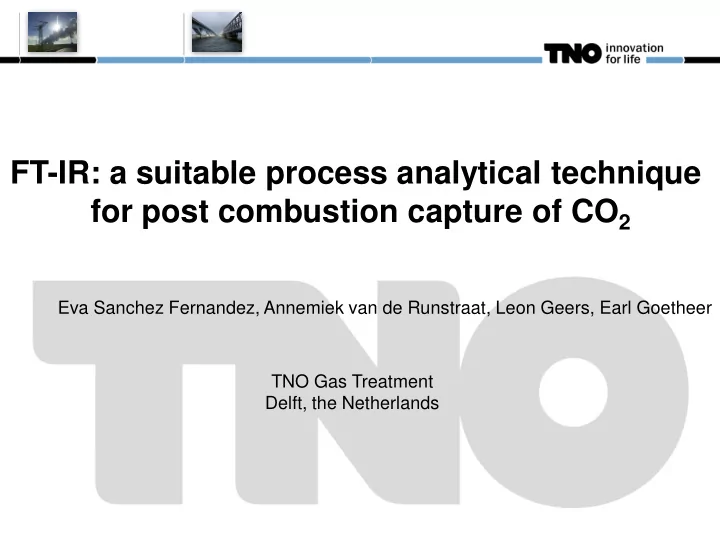

FT-IR: a suitable process analytical technique for post combustion capture of CO 2 Eva Sanchez Fernandez, Annemiek van de Runstraat, Leon Geers, Earl Goetheer TNO Gas Treatment Delft, the Netherlands
1 23/5/11 TNO Gas Treatment Group Content Why PAT? Principles of FT-IR Model construction Demonstration Conclusions
2 23/5/11 TNO Gas Treatment Group Why PAT Compromising capturing efficiency: Thermal degradation of amine due to heating/cooling cycles Chemical degradation of amine due to formation heat stable salts Contamination of solution with other species in flue gas Evaporation of water from amine solution Temperature fluctuations Optimal performance Better process understanding necessary But ... first step is monitoring concentrations Goal: Development of in-line monitoring system for concentrations of CO 2 , active amine, and heat stable salts
3 23/5/11 TNO Gas Treatment Group CO2 content Framework: post combustion capture of CO 2 Amine content HSS content
4 23/5/11 TNO Gas Treatment Group Measurement technique: Fourier Transform Infrared Spectroscopy Flexible many different species In-line applicable no “running to the lab” with samples Fast order of a minute Non-contaminating without addition of internal standards N Infrared Chemical bonds light absorption stretch or bend C H Model system: potassium b-alanine
5 23/5/11 TNO Gas Treatment Group Comparison potassium salt and - carbamate Potassium salt β -alanine Potassium salt β -alanine carbamate Carbonate Conclusion: No straight forward dependency species and FT-IR peaks
6 23/5/11 TNO Gas Treatment Group From IR spectra to concentrations? [Amine - ] 2- ] [CO 3 ? - ] [HCO 3 - ] [Amine-CO 2 [Heat Stable Salts] [ ... ? ... ] • Absorption is wavelength dependent peaks of specific bonds may overlap • Water absorbs over broad band might obscure peaks of other species • Chemical reactions peak shifting or disappearance • Temperature fluctuations affect spectra
7 23/5/11 TNO Gas Treatment Group Partial Least Squares Model – Creation 1 2 3 ... n ... X T YY T X Spectra (X) Covariance matrix … … # # Y1 Y2 Yp 1 2 p … … 1 1 1.31 1.31 2.60 2.60 12.3 12.3 … … 2 2 2.33 2.33 6.20 6.20 23.5 23.5 Basis functions : : : : : : : : … … n n 0.01 0.01 9.99 9.99 16.9 16.9 Concentrations (Y)
8 23/5/11 TNO Gas Treatment Group Partial Least Squares Model – Regression + error = T 1 * + .. + T m * + T 2 * Coefficients T 1..m contain information to calculate species concentrations More basis functions better fit BUT more rigid model Caveat: Non-informative correlations may be present in spectra preprocessing necessary
9 23/5/11 TNO Gas Treatment Group Experiments Calibration + validation 28 Stock solutions were created of amine in 4 different concentrations CO 2 and SO 2 were added with a bubbler CO 2 concentration measured with phosphoric acid method IR Spectra collected with FTIR spectrometer and ATR flowcell Testing 7 samples from pilot plant capture installation of both lean and rich streams
10 23/5/11 TNO Gas Treatment Group C-O stretch Results – Basis functions Amine peaks (e.g.H-N-H bend) N-H stretch N-H, but also S-O
11 23/5/11 TNO Gas Treatment Group Calibration and validation matrices (37) (15)
12 23/5/11 TNO Gas Treatment Group Results – Validation 2.5 Reconstructed Amine conc. (M) Reconstructed CO2 conc. (M) 6 2 5 1.5 4 1 3 0.5 2 0 1 0 0.5 1 1.5 2 2.5 1 2 3 4 5 6 Measured Amine concentration (M) Measured CO2 concentration (M) Reconstructed SOx conc. (M) 1 0.8 0.6 0.4 0.2 0 0 0.2 0.4 0.6 0.8 1 Measured SOx concentration (M)
13 23/5/11 TNO Gas Treatment Group Results – Pilot plant RMS Error: ~0.04M
14 23/5/11 TNO Gas Treatment Group Results pilot tests
15 23/5/11 TNO Gas Treatment Group Microplant pilot equipped with on-line FT-IR
16 23/5/11 TNO Gas Treatment Group Test 1: 100 spectra recorded on-line show stable operation Colour intensity Time is measure of peak intensity
17 23/5/11 TNO Gas Treatment Group Test 2: process event identification CO 2 + SO 2 SO 2 Water replenishement
18 23/5/11 TNO Gas Treatment Group Test 3: Model robustness CO 2 CO 2 + SO 2 CO 2 + SO 2 + NO x
19 23/5/11 TNO Gas Treatment Group Test 3: Model robustness – SO 2 in rich stream CO 2 CO 2 + SO 2 CO 2 + SO 2 + NO x
20 23/5/11 TNO Gas Treatment Group Conclusions Methodology for reconstructing solvent concentration from FT-IR concentrations developed Accuracy of predictions on-line within 10% For calibrated species in calibrated range Model can be trained to discard noise from contaminations of other species Process event identification possible using this tool extra input of information for process control FT-IR is a suitable process analytical tool
21 23/5/11 TNO Gas Treatment Group Acknowledgement: Ralph Joh and Rudiger Schneider (Siemens)
Recommend
More recommend